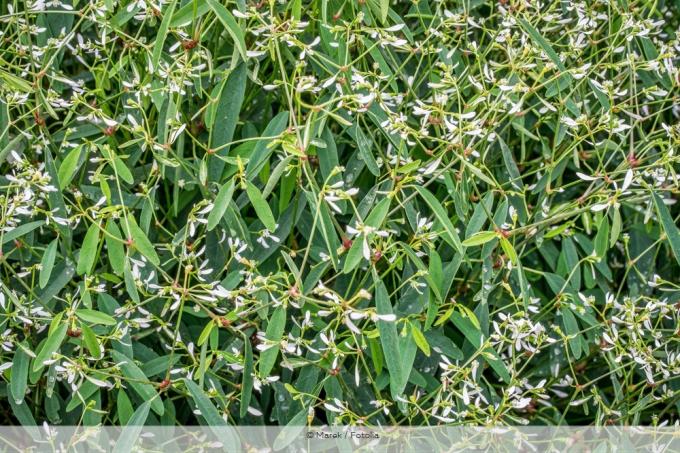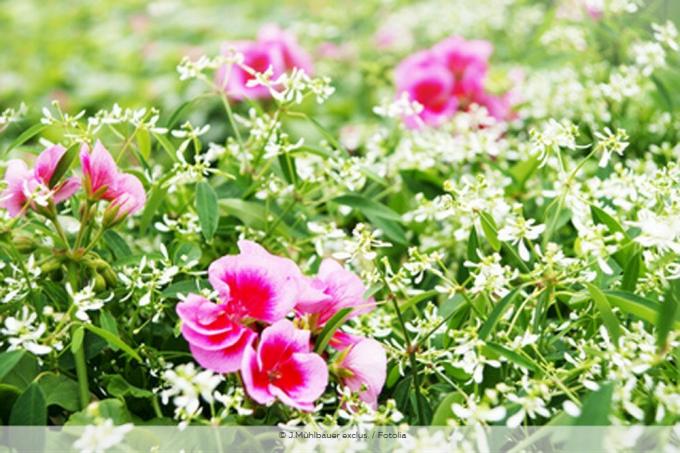
table of contents
- Magic snow
- Hardiness
- Hibernating magic snow: instructions
- 1. Optimal balcony replacement
- 2. Move, but early!
- 3. Cut
- 4. care
- 5. Diseases and pests
- 6. abstract
- Does wintering always make sense?
The balcony plant Magic snow has well earned its unusual name. It conjures up one white flower after the other, each one the size of a snowflake - all in the middle of summer. But what happens to the magic snow when the real snow appears? Usually, as an annual plant, it has to go forever! Unless you give him an extension of his life in a well-tempered neighborhood.
Magic snow
Annual or perennial?
In the case of an annual plant, the question of winter hardiness hardly arises. It only grows for one season, then dies and is then disposed of. The magic snow is also sold as an annual balcony plant and consequently suffers from this fate. What few people know, however, is that under ideal conditions, the plant can thrive for several years. Then, however, the winter hardiness is also an important factor when it comes to wintering.
Hardiness
How much cold can the magic snow tolerate?
The Chamaesyce hypericifolia, as this beautiful plant is called botanically correct, is not hardy. That is also the reason why it is referred to as annual in the trade. Because most balcony owners lack suitable winter quarters and so they have to assume they will live for a year.
- The plant does not like temperatures below 8 ° C
- even a slight frost damages them considerably
For these reasons, the plant urgently needs a well-tempered place to overwinter, which it must not move into too late. The following are detailed instructions with which you can safely bring your “magical snow” into the next summer.
Hibernating magic snow: instructions
1. Optimal balcony replacement
A place that is only frost-free is not good enough. A very long stay awaits the magic snow, during which it also has some demands. He should offer him the following amenities:
- Temperatures above 8 ° C, also warmer
- the comfort of living spaces is also accepted
- enough light
- Protection against drafts
- good access to watering
tip: Despite the required brightness, the Chamaesyce hypericifolia should not be exposed to direct sunlight in its winter quarters. While she can tolerate this on the balcony in summer, the temperature fluctuations that it triggers can now damage her.
2. Move, but early!
Once the optimal winter quarters have been found, it is now a matter of timing the move precisely. The magic snow should stand in the open as long as possible and soak up the last rays of sunshine. Since the weather is different every year, the owner must keep an eye on it. Looking at the weather forecast is a must because frosts can come as a surprise.
- when the cold is approaching, the move must take place
- at the latest before the temperature falls below 8 ° C
However, if the autumn days or nights are particularly humid, this can already be the case in connection with temperatures below 15 ° C Putrefaction to lead. In this case, it is better not to wait, but rather to move earlier.
3. Cut
If the available space in the winter quarters is too cramped for the balcony plant, which is well developed during the summer, the scissors can be put on right at the beginning. The crop tolerates pruning well, but this might not be good for the shear operator. Chamaesyce hypericifolia is poisonous, which is why protective gloves are mandatory when cutting.
tip: If you have pets, you should also make sure when choosing a place that they cannot easily reach the poisonous plant.
4. care
Since the plant is not hardy at all, its roosting period can last from November to May if the weather conditions are unfavorable. During this time, one or the other maintenance measure must be carried out, even if not as often as on the balcony.
- no nutrient supply required
- however, the earth should never dry out completely
- the warmer the pot is, the more often it has to be watered
5. Diseases and pests
Occasionally make themselves in the winter quarters Spider mites about the plant. Regular checks are important in order to detect the pest at an early stage and to combat it effectively. This step of the instructions should never be skipped lightly. Spreading to other plants can be prevented by removing diseased specimens if necessary. to be isolated.
Dark and soft plant tissue could be a sign of Botrytis be. It is a mold that also likes to attack neighboring plants. If the magic snow is infected with this fungus, it unfortunately has to be disposed of immediately.
6. abstract
The first warm rays of sunshine of the year lure you out into the open air, but the balcony is far from being adorned with the magic snow. To middle of May A few nights of frost can come in between and irretrievably destroy the plant that was so laboriously brought through the winter.
Only take the plant out of the warm area when the temperature outside is consistently more than 8 ° C. And should the frost announce itself, the magic snow has to be brought in again.
Does wintering always make sense?
Hibernation always makes sense for the plant, because after all it wants to live. For plant lovers, on the other hand, what counts above all is the good looks and the flowering performance. This is exactly where the crux of the matter lies when it comes to wintering this balcony plant:
- overwintered plants bloom later than young specimens
- with age, the compact form is lost more and more
- the number of flowers also decreases
The longer the life of the magic snow, the more its appearance deviates from the ideal. Every year a new decision has to be made here that overwintering is worth the effort.



